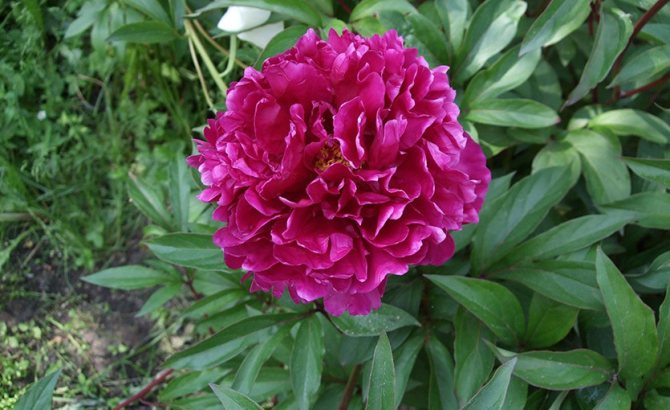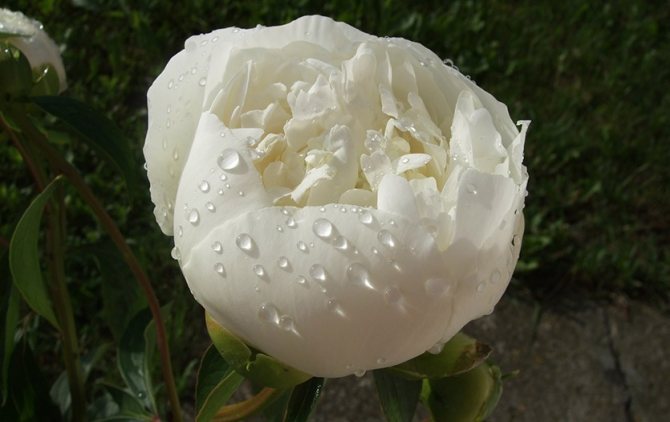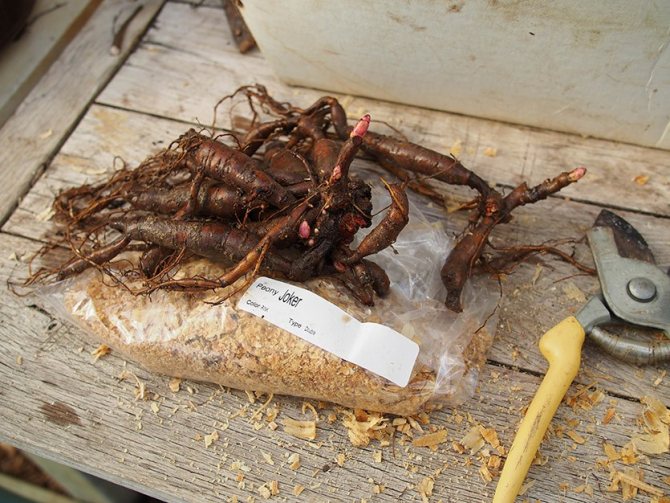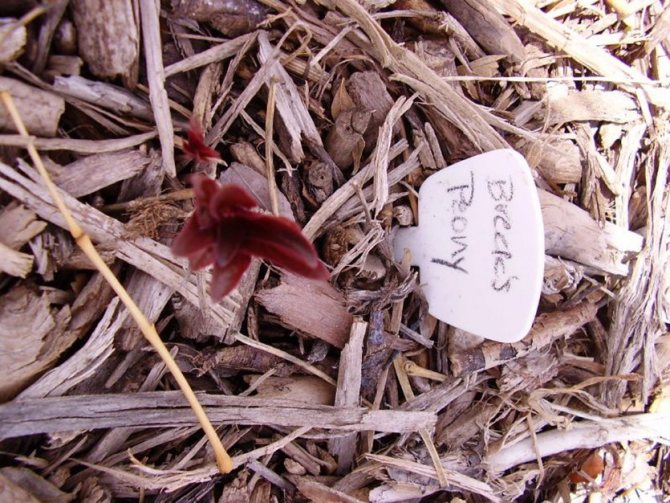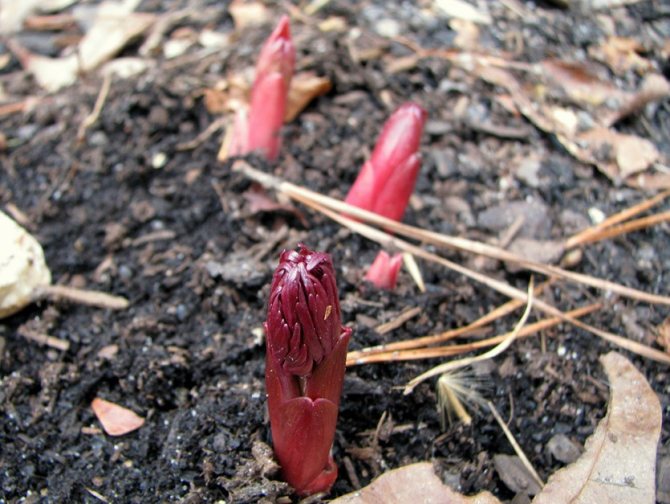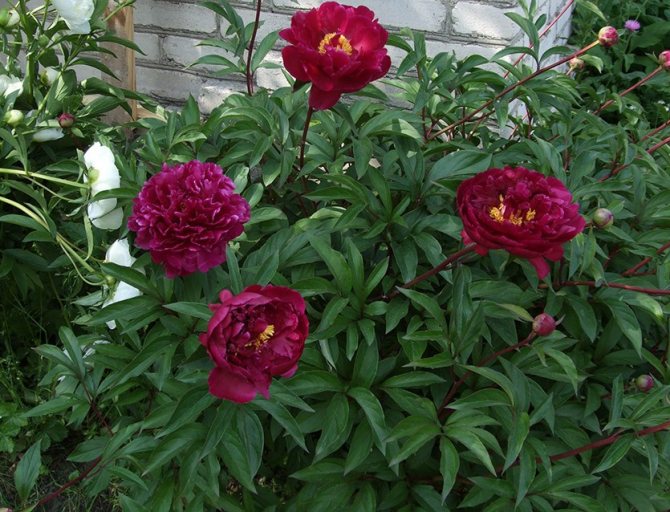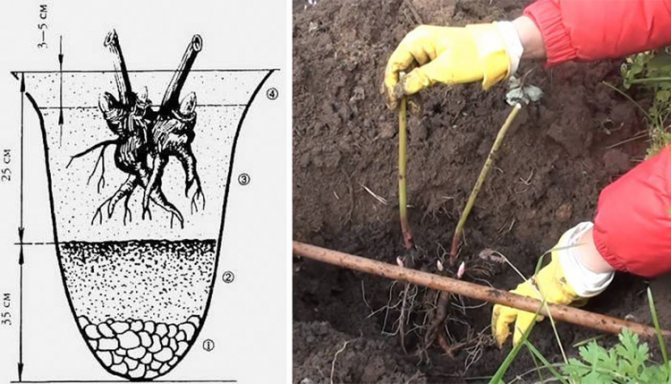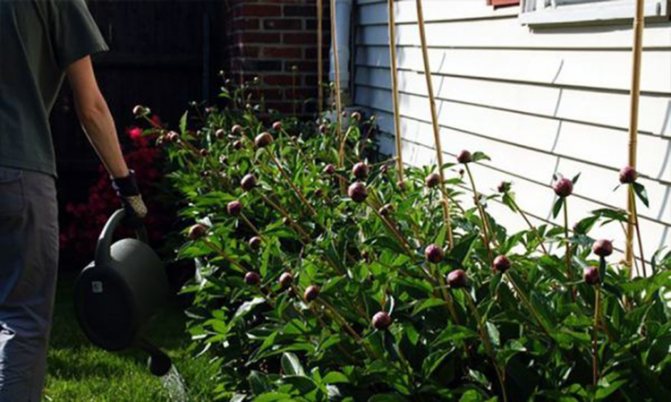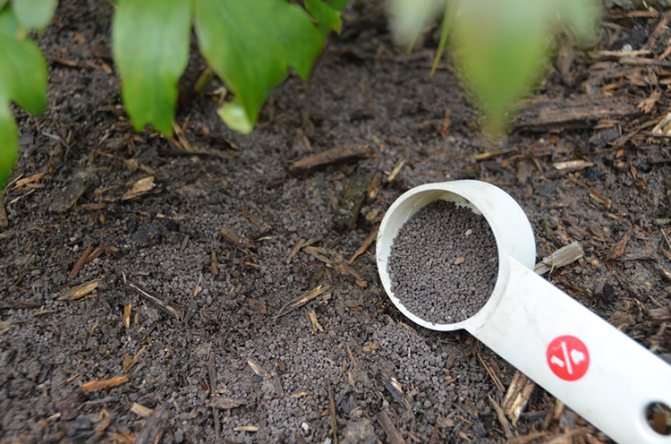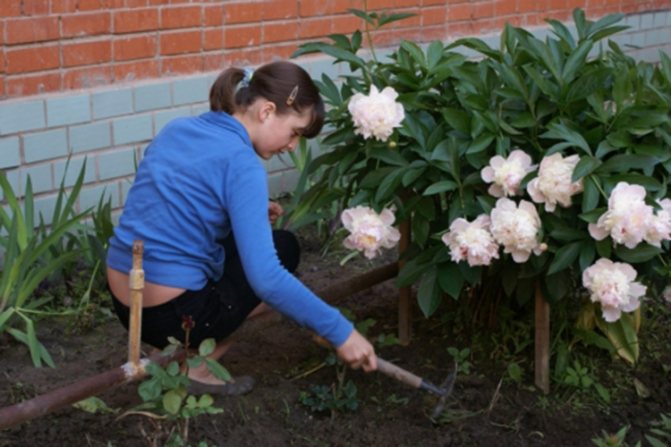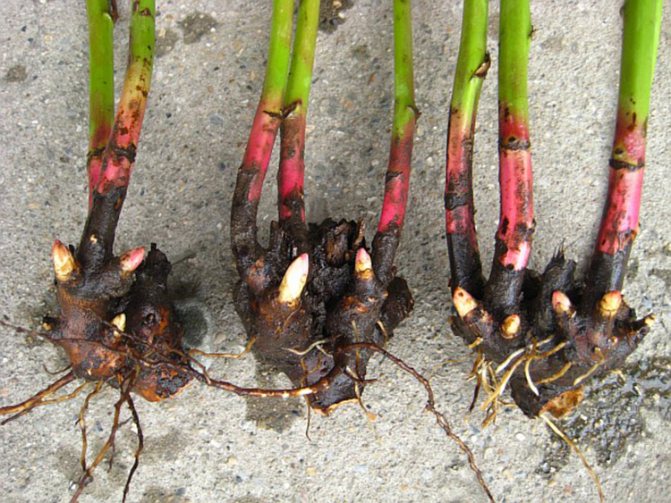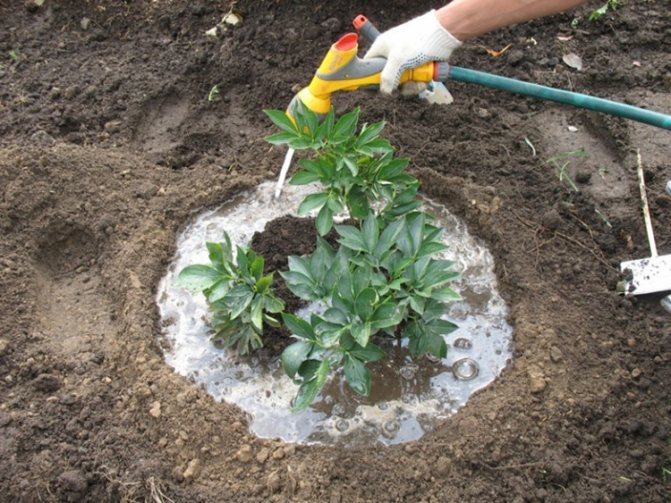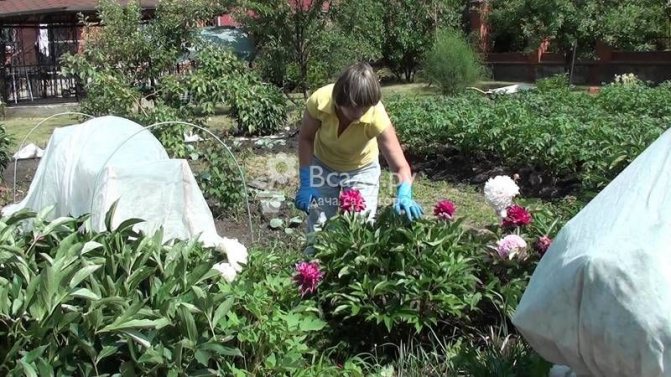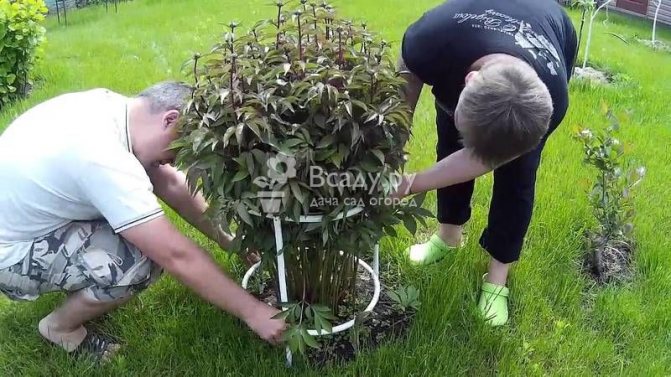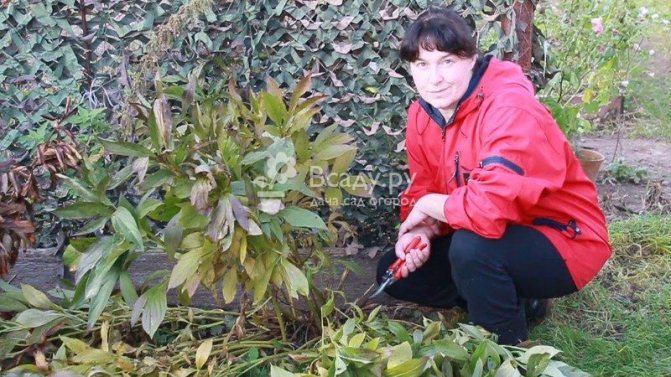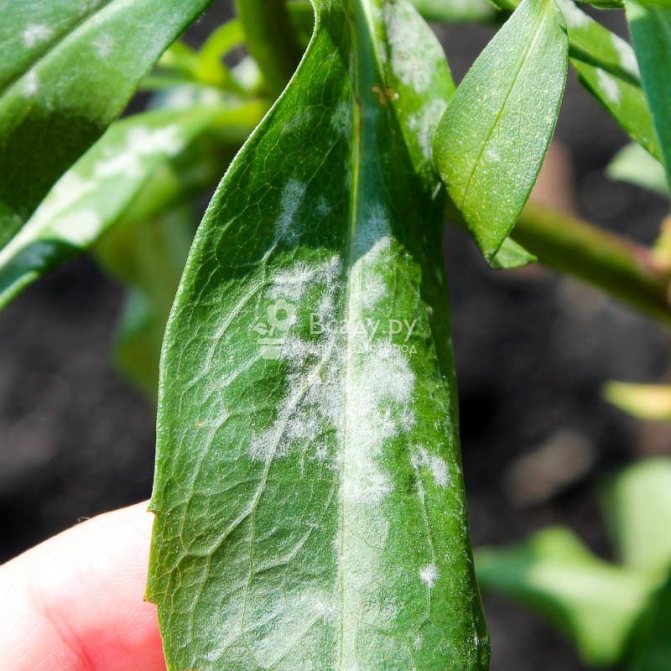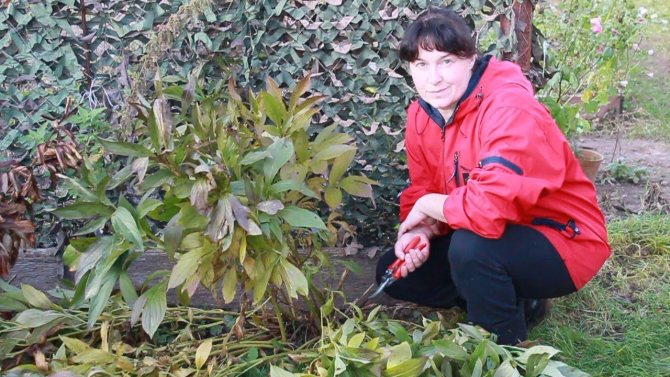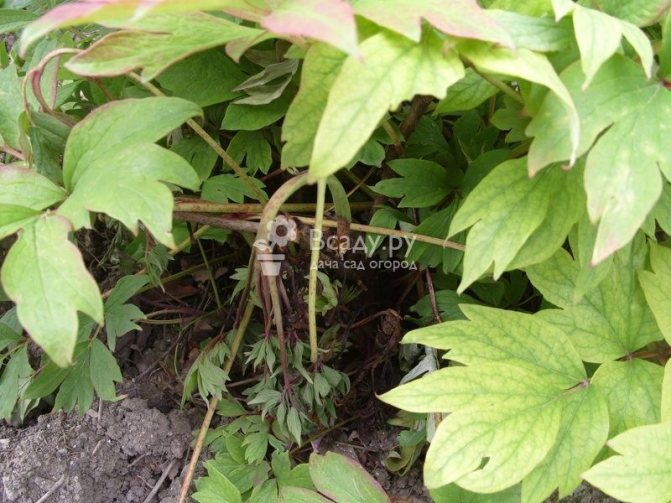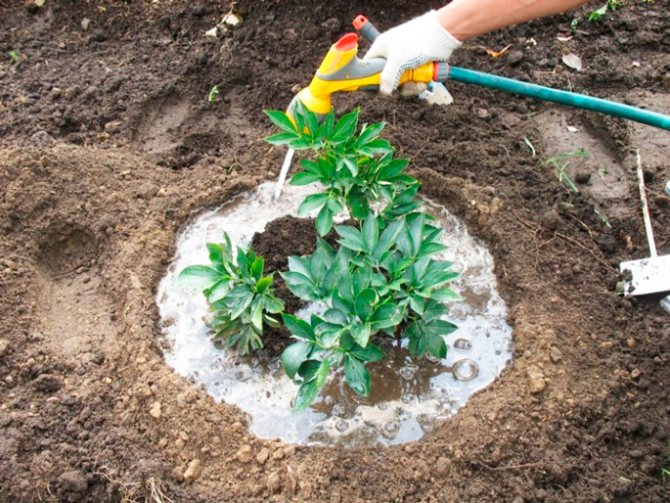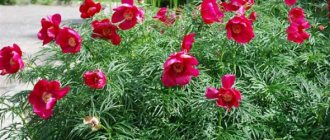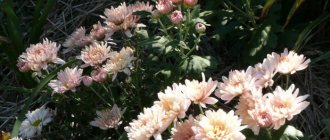Planting and caring for peonies outdoors is an important topic for anyone involved in flower cultivation. It is not enough just to submerge the plant in the ground, you also need to know how to properly care for it, how to fertilize it, when it is best to plant it, and so on. We recommend that you carefully read our article, in which you will find answers to all your questions and learn how to properly plant beautiful peonies and take care of them in your own garden.
An interesting fact is that these flowers got their name in honor of a character in Greek mythology named Peon, who got used to treating the Olympic gods from all sorts of ailments using decoctions and tinctures on this particular plant. Even today, some varieties of peonies are considered healing.
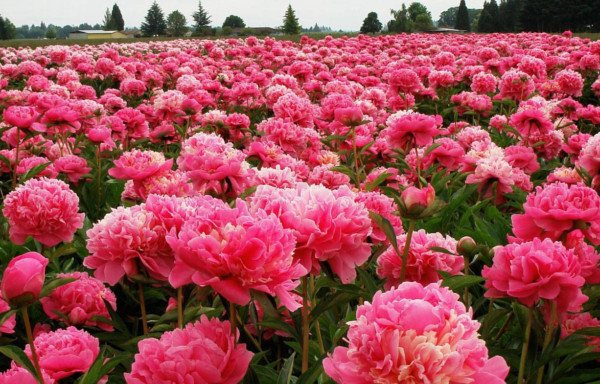
By itself, this flower is a herbaceous plant, but there are peonies that grow as shrubs or semi-shrubs and belong to treelike plants. In order for your flowers to grow beautiful and healthy, they need to be planted according to certain rules. You will learn how to plant peonies correctly in the next section.
Peonies description and plant varieties.
Peonies are perennials of the Peony family, which are divided into 2 main varieties: herbaceous (about 500 varieties), and tree-like (more than 4 600 varieties). There are also many hybrids that combine the best qualities of these two species.
Treelike peonies grow in the form of bushes on solid tall stems. The plant blooms for 2-3 months, starting in June, and loses its leaves for the winter. Over time, new shoots grow, which gradually harden. The flowers of the tree peony are lush and large. There are different shades depending on the varieties.
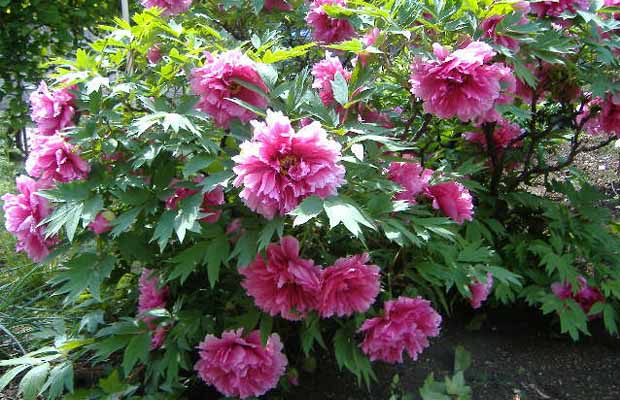

tree peonies
The herbaceous peony has a powerful root from which soft stems grow. Throughout the season, the plant actively grows new leaves, the color of which varies from green to dark purple in different varieties.
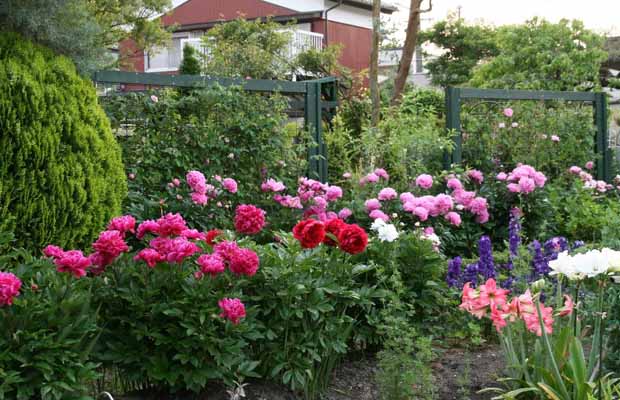

herbaceous peony
The main differences between tree and herbaceous peonies:
Herbaceous peony - the stems are soft, the flower diameter is up to 20 cm, the plant height is 1.5-2 meters, the planting is shallow, you need to cut the flowers the first two years after planting.
Tree peony - the stems are solid, the flower diameter is up to 30 cm, the plant height is 1 meter, the planting is recessed, you need a shelter for the winter.
One of the popular varieties of herbaceous peonies is evading, also called Maryin root. The stems and rhizomes of this plant are used to prepare a tincture that:
- improves skin condition, rejuvenates it;
- relieves dandruff, strengthens hair follicles;
- calms the nervous system;
- helps in the fight against gynecological diseases and diseases of the gastrointestinal tract.
Medicines based on a tincture of a duck peony should be taken only as directed by a doctor in an appropriate dosage, because large doses are poisonous.
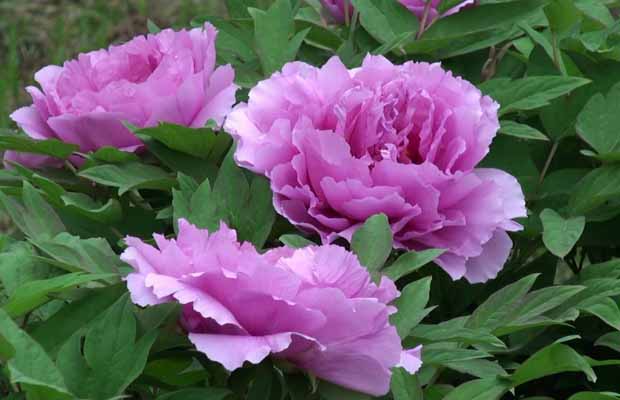

Due to the extensive systematic and botanical description of peony on Wikipedia, we will not deal with this, because it will be a duplication of what already exists. For those who want to get to know this more thoroughly, you can click on the link on Wikipedia.
Soil composition
Regardless of the variety, pion
needs one type of soil.It must necessarily be well-drained and cultivated. Here are some characteristics of the earth in which this flower can feel comfortable:
- nutritious;
- permeable;
- slightly alkaline;
- loamy;
- slightly alkaline.
To ensure ideal soil, the soil needs to contain a lot of humus. In order to reduce the acidity of the earth, you can add a little lime, with an excessively clayey composition, peat and sand are added. Organic matter and clay are mixed only if there is too much sand in the soil.
Soil preparation should be done three weeks before planting. A hole is dug about 70 cm, no less, since the roots tend to penetrate deep to 80 cm. If on their way they see an obstacle, they will find another way, crawling out to the surface. And, naturally, in this case there will be an acute lack of nutrients. Therefore, you need to plant a flower in the upper part of the pit, leaving the rest of the space for the future root system.
Reproduction of peonies.
There are several ways to breed peonies, but the simplest of them is the method of dividing the bush. It can be produced from August to September according to the following scheme:
- tie or cut the leaves of the plant;
- carefully dig the root out of the ground;
- wash off the soil from the root;
- remove diseased and defective roots, and shorten healthy ones to 15 cm;
- divide the root into several parts (make sure that there are at least 3 buds and 2 strong roots on each division);
- plant the divisions in the pits, sprinkling the buds with earth;
- water and mulch the soil at the planting site.
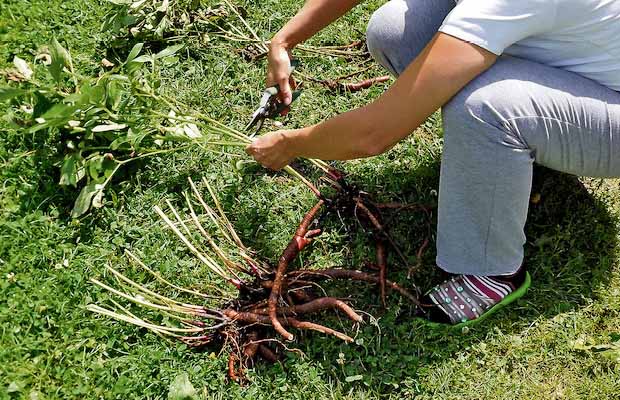

Peony propagation by seeds is a very long and painstaking method. It is usually used by breeders to develop new varieties. Some experts grow peonies with root cuttings, stem cuttings, and layering. In horticulture, these breeding options are not very popular due to the complexity and low survival rate of seedlings.
Purchase of a seedling
Important points:
- The first planting of Peonies on the site is carried out after purchasing a high-quality base.
- The best option is healthy, well-developed rhizomes from a three to four year old plant, always with 3-4 points of growth.
- Annual seedlings are also suitable, but it is better to take part of an older bush.
- The rhizomes should be clean, light, without damage, at least 20 cm long, preferably 25 cm.
- Signs of poor quality seedlings: growth points are damaged, roots are black or dry.
It is useful to buy planting material from reputable nurseries or from experienced growers so that the owners can provide quality rhizomes with buds from strong, mature shrubs. Only if this condition is met can abundant flowering and good vegetation be achieved.
How to plant a peony: herbaceous and tree-like.
Better to plant peonies from September to August. Such flowers get sick less often than those planted in spring, and most importantly, they take root well. Accordingly, the transplantation of herbaceous species should be done at the same time. In general, the procedures for transplanting and planting peonies from cuttings are identical.
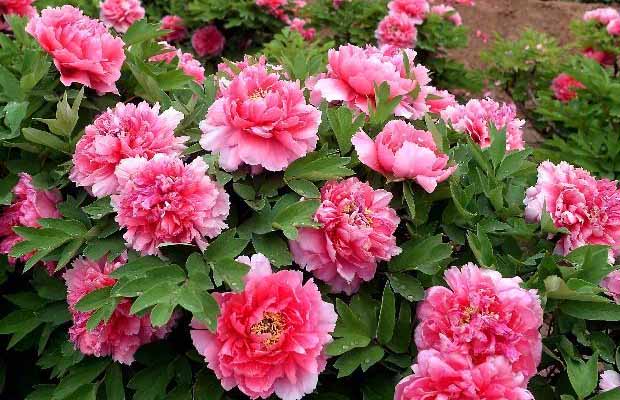

It is important to choose the right place for the peony: it should be sunny, with shade at noon. Peonies can grow in the shade, but, at the same time, they will not bloom. Remember that peonies are alpine plants, so they prefer cool places and will bloom best in cool, dry years. For the same reasons, the eastern and western sides of the site are more suitable for planting peonies. Although the plant loves the sun, the southern side is the least favorable for it. The peony will bloom even in partial shade, although there will be much less flowers.
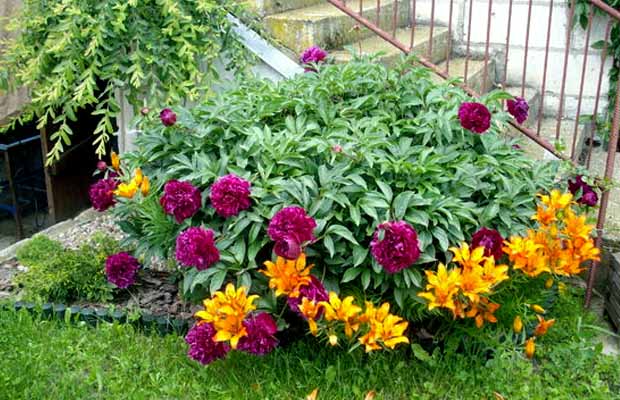

Due to the initial problems with the efficiency of the root system, it is necessary to properly prepare the soil. Taking into account the love of peonies for loose soils, we will try to pamper them. The best soil for peonies is slightly acidic loam.Sandy soils can be refined with a little compost or clay: this will improve both the structure and composition of the soil.
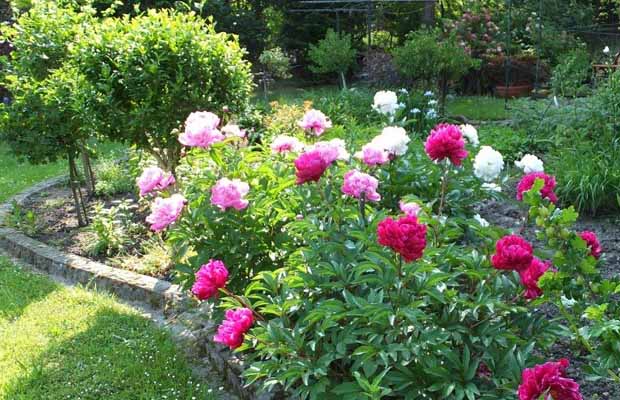

If you have clay soils, make sure there is no stagnant water. If after a lot of rain in the place you have chosen, the puddles stand for more than an hour, this is not a place for peonies, and nothing will help here, because stagnant water is the biggest enemy of peonies. You must choose a different location. If the water does not stagnate, good drainage must be done for the clay soil: we leave at least 10 cm of the drainage layer under the roots of the plant. It is much better to use gravel than sand for it.
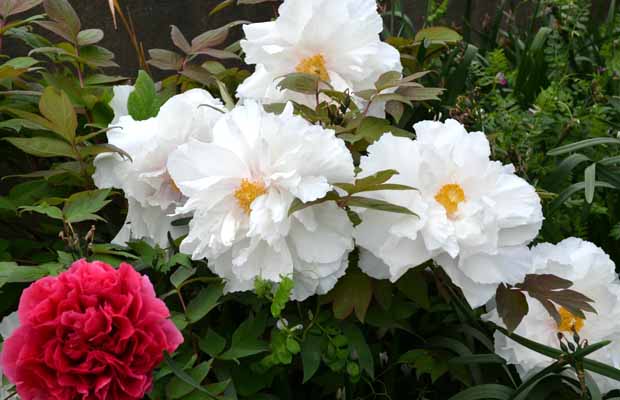

How to plant a herbaceous peony:
- prepare a hole, the depth, width and height of which is 60 cm;
- mix 15 kg of organic matter with superphosphate (200g) or bone meal (350g), add soil;
- half fill the hole with the resulting mixture;
- Pour a 20 cm layer of sand on top of the nutrient mixture;
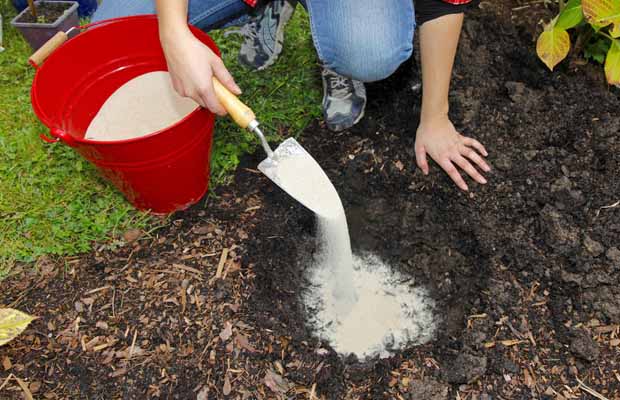

- place a seedling in the hole so that the replacement buds are 5 cm below ground level (if you place them higher, the plant will hurt, and if deeper, problems with flowering will appear);
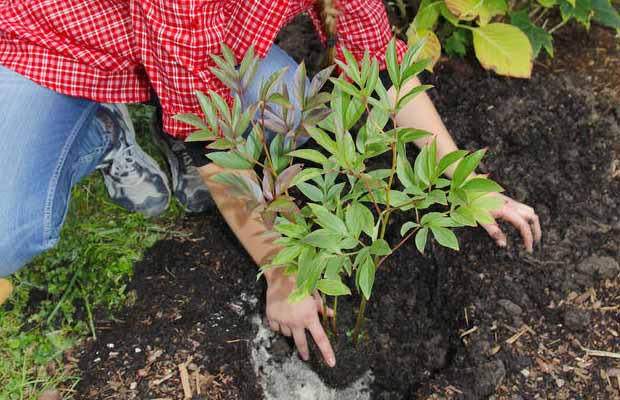

- cover the root with soil, lightly compact with your hands;
- water and mulch the land with manure or peat;
- be sure to leave a distance of 0.9-1.5 m between the divisions.
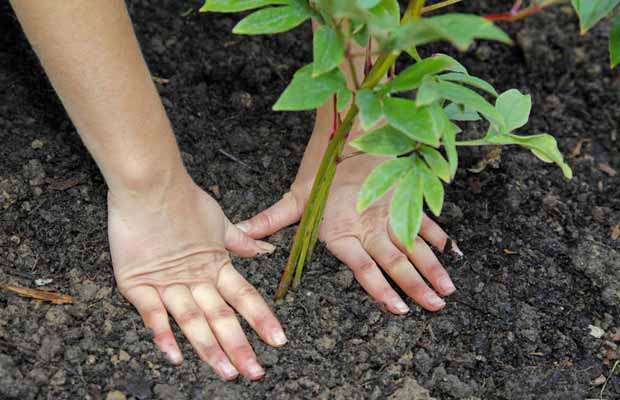

How to plant a tree peony:
Plant tree peonies in partial shade, in a place protected from strong winds. At the bottom of the pit, pour a mixture of soil and fertilizers (200 g each of superphosphate, dilomite flour, potassium sulfate). Place the seedling in the hole so that the root collar is 15 cm below ground level. Before filling the plant with a mixture of compost and soil, pour a bucket of water into the hole until it is completely absorbed. When planting is complete, water the seedling abundantly and mulch the ground around it.
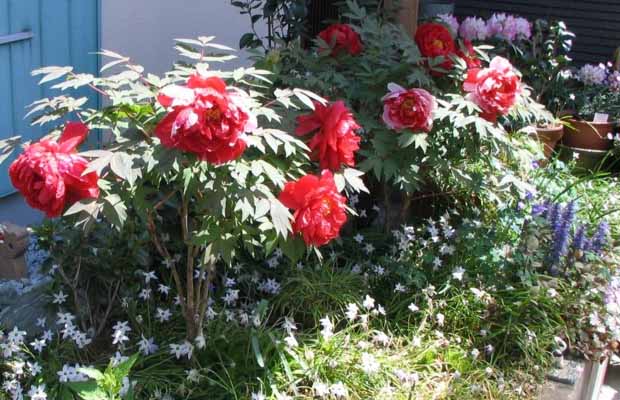

The roots of a newly planted tree peony will constantly seek and follow water. Therefore, the root can grow several meters. This is one of the main reasons for the low transplant tolerance. Therefore, after transplanting, it is necessary to act with the plant as with a baby - regularly water, loosen and cover for the winter.
The difference is in the planting of a herbaceous and tree-like peony.
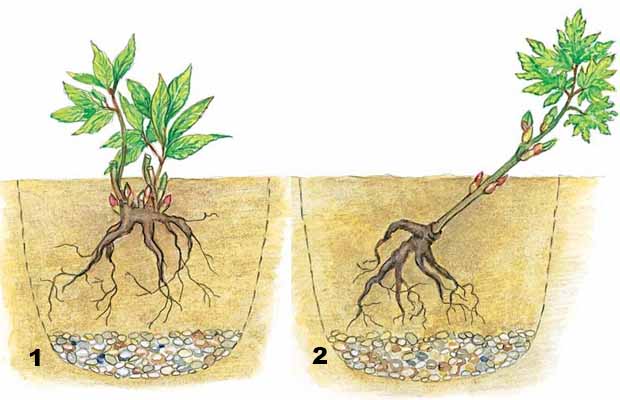

- Herbaceous peonies should not be planted too deep, otherwise they will not bloom.
- Tree peonies they are planted deeply, so that the root collar is covered with soil for at least 10-15 centimeters - only then can it form its own roots. The second difference in planting herbaceous and treelike peonies is the leaning position of young plants. This little trick makes tree peonies form larger shoots and thus grow more dense.
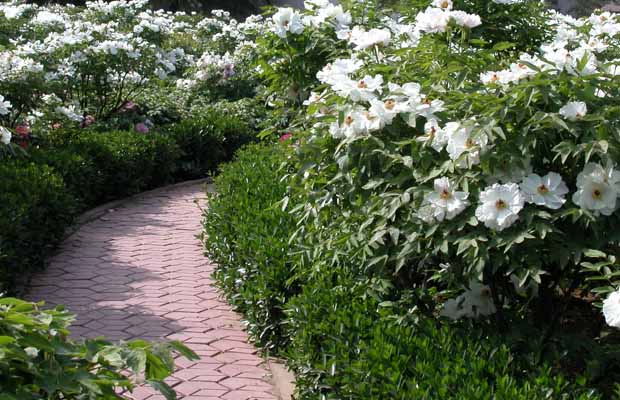

The specificity of the root system of peonies means that it does not tolerate transplanting. Therefore, be serious about choosing a landing site. Also, keep in mind that after a few years they will become a large shrub, so you can only plant plants around them that can later be easily transplanted elsewhere and that do not compete with them for water. So, due to fierce competition for water, the peony should not be planted near shrubs.
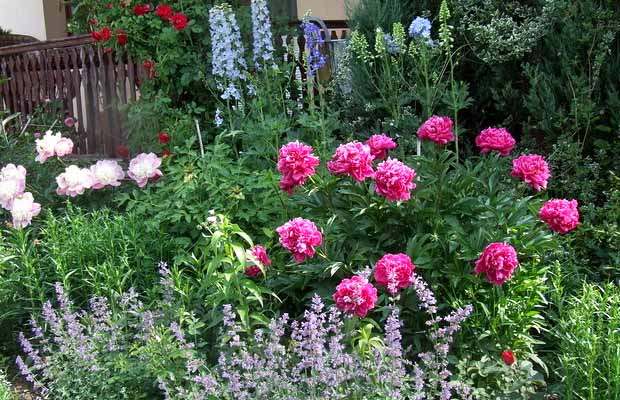

Protection from pests and diseases
Helpful information:
- Most of all, peonies are afraid of waterlogging. If the plants "float", then with a high degree of probability you can lose the bushes against the background of active rotting of the roots. It is easier to prevent excess moisture in the soil than to deal with root rot.
- The affected plants are dug up, the condition of the root system is checked. If there is hope to save the bush, then the rotten elements are removed, the roots are treated with fungicides and Fitosporin Reanimator to restore vitality.
- A drainage layer is arranged in a new place, the irrigation regime is adjusted, taking into account the quality of the soil and the nature of the site.It is important to identify and eliminate errors of care and planting, against the background of which there was a boggy substrate and rotting of the underground part.
- When harmful insects are detected on plants, insecticides are used, when a spider mite is populated, acaricides are used. Pests on a peony rarely settle; when parasites multiply, timely treatment with biological and chemical agents is needed. Be sure to water the soil with preparations, in addition to spraying the stems and leaves.
- It is important to wear gloves, a respirator, plastic glasses, a cap, closed clothing so that fungicides, acaricides and insecticides do not lead to human poisoning.
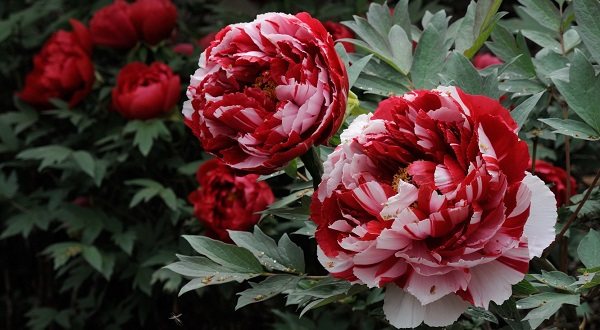

Peony care.
For herbaceous peonies, the first 2 years after planting, you need to cut the buds. This is necessary to strengthen the root system and form lush buds in the future. This is not necessary for tree species. Peony care should include:
- abundant watering during the periods of bud formation, flowering, budding (August);
- weed removal;
- loosening and mulching the soil around the flower;
- spring pruning of tree-like peonies to form the crown (this is important to do before the buds open);
- since peonies have large flowers, it is good for them to make a support in the spring so that the bush is compact and does not disintegrate under the weight of the flowers.
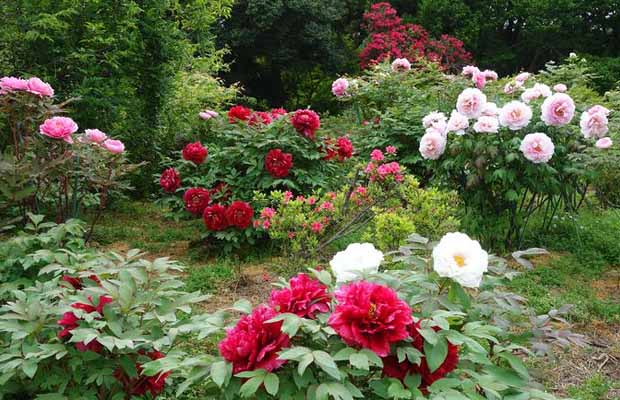

How to feed a peony?
Although peonies are not big gluttons, do not forget about top dressing. Starting from mid-spring, young plants need to be watered monthly with universal organo-mineral fertilizer with the addition of liquid soap (1 tbsp. L / 1 bucket of water).
Fertilize peonies older than 2 years in 3 stages every 3 weeks, starting in May:
- solution of urea and water (50 g / 10 l);
- solution of urea and water (50 g / 10 l) +1 tab. microfertilizers;
- solution of urea and water (50 g / 10 l) +2 tab. microfertilizers.
In mid-spring, feed the soil with fertilizer containing potassium and nitrogen (15 g per plant). Water the flowers with the cow dung solution while the buds are forming. At the end of flowering, it is recommended to fertilize the soil with potassium-phosphorus feed (15 g per plant).
Advice. Do not overdo it with fertilizing the peony with mineral fertilizers, especially nitrogen fertilizers. With an excess of nitrogen, it can happen that the leaves will grow magnificently, but the peony will bloom in one flower or not bloom at all. In addition, a plant that is too fertilized is susceptible to fungal diseases.
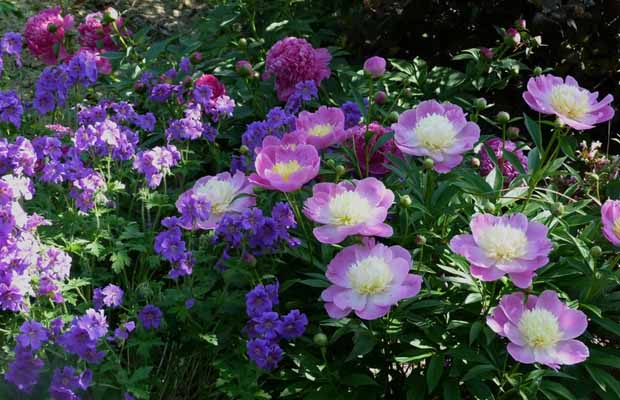

What to do if peonies are not blooming?
Sometimes this is due to improper planting of the peony. Most often, you just have to wait: the first flowers on herbaceous peonies will appear in 2 years, and for several years it will come into full force until it reaches its maximum flowering. For tree species, you will have to wait several years before full flowering begins. This is due to the slow development of the root system in this species of peony.
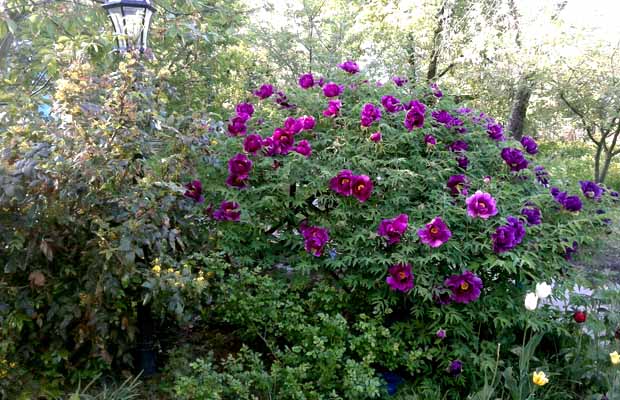

Technology and rules for planting in open ground
Having chosen a suitable place for the future flower garden, you need to start watering it in 2-3 days. This time is enough for the earth to fill with moisture and become soft. Then dig a hole 70 cm deep, 1 m in diameter.You need to plant peonies, adhering to the following rules:
- put a mixture of humus and a potassium-phosphorus supplement on the bottom of the dug hole. You can replace mineral fertilizers with wood ash;
- if a large bush was purchased, its roots must be carefully divided. It is most often impossible to do this manually, so you will need garden shears;
- the roots must be laid out in the pits. It should be covered with earth in such a way that the upper kidney is located 1 cm below the ground;
- the soil needs to be pressed down a little to release the air;
- be sure to water abundantly after planting.
Diseases of peonies.
Another important condition for caring for peonies is the fight against diseases and pests. Characteristic spots on the leaves, weakening, deterioration in the appearance of the plant may indicate the presence of one of the common problems:
- Rust - brown spots of fungal origin on the leaves, which quickly spread through the air from a diseased plant to a healthy one. Parts of perennials infected with rust must be cut off and disposed of, and the bush itself must be treated with Bordeaux liquid.
- Powdery mildew - white bloom on the leaves. Processing with a mixture of households is required. soap and soda ash.
- Gray rot (mold) - affects the entire plant, leading to its death. Sick areas should be disposed of, after which the plant should be sprayed with Thiram's liquid.
- Viral mosaic - the leaves are covered with light green and dark green spots, which alternate with each other. A diseased plant must be removed from the site.
- Spot - the formation of dark spots on the leaves with a purple or brown tint. It is necessary to remove the diseased flower, and treat the area with Bordeaux liquid.
- Unreasonable weakness of the plant, lack of flowering, swelling in the root area - these problems indicate Lemoine's disease. The diseased plant must be disposed of.
- It is impossible to save peonies infected with verticillary wilting. This disease is recognized by the unreasonable weakening and drying of young leaves, stems, buds.
Also, make sure that the plant is not affected by pests: ants, aphids, root nematodes, thrips, and hop silkworms. Some pests can be removed manually, but more often you have to use special preparations.
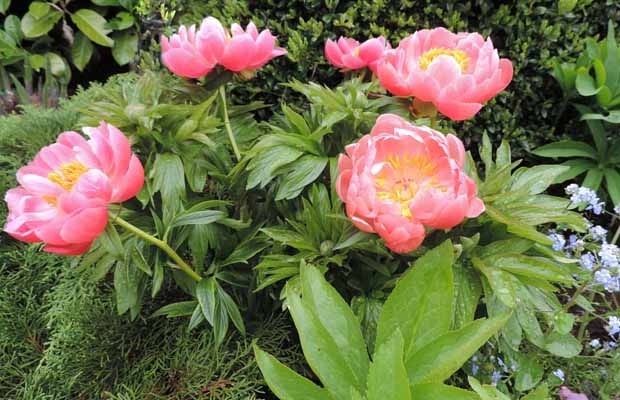

Important nuances
The advantage of peonies is that they can grow for half a century without changing their place. Therefore, it is very important that when planting, fertilizer is poured into each hole before planting a flower in it. A small secret of plant feeding is that a certain type of fertilizer is added at each specific growth period. Let's consider this one by one:
- immediately after landing - nitrogen;
- in the process of growth and the appearance of buds - fertilizer with minerals;
- at the end of flowering - potassium, phosphorus.
As for mineral fertilizers, you should first water the plant in grooves, about 10 cm deep, dug around the entire circumference of the bush. Then fertilizing with minerals is poured, exclusively in liquid form. You should also not think that at first he does not need nutrient soil, it is at this time of growth that he really needs top dressing.
More articles about peonies:
In winter, do not cover with peat (dry), because due to its acidic reaction it is contraindicated for these flowers. Only a neutral reaction is suitable, and no other. Regular testing of the soil for acidity is a prerequisite for the full development and flowering of peonies.
There is no doubt that real flower growers receive amazing multi-colored bouquets from their flower gardens in due time. But this is also within the power of just amateurs who have just recently taken up the cultivation of these fragrant beauties.
The fragrant flowers of peonies, from pale white to crimson, are a symbol of summer - warm and generous. This fragrant beauty can delight you (and even your grandchildren) for several decades without requiring much effort. To get a bunch of large flowers on an elastic stem, you need to have a good idea of how to plant peonies. Particular attention should be paid to the division time of the bush, in this peonies differ from other plants. There are special requirements for the planting depth.
Peonies have faded - what to do?
When winter comes, prune the leaves of the herbaceous peonies as close to ground level as possible and sprinkle the soil with ash. For tree species, shelter is required: mulch the ground with peat, and wrap the stems with burlap or dense cloth until spring.
With proper care, herbaceous peonies grow in one place for about 15 years, and tree species even longer. Therefore, do not be lazy to follow the recommendations for keeping these wonderful perennials that will decorate your site every summer.
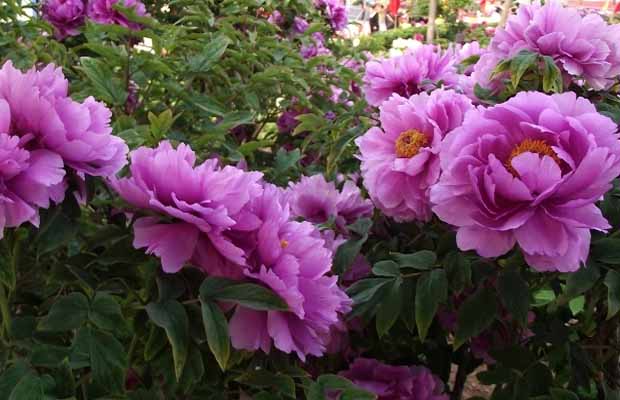

Peonies not only look great in the garden.They are also gorgeous cut flowers that last up to 10 days in a vase. To enjoy their appearance and smell in the house for a longer time, it is better to cut peonies in buds. The best time to cut is early morning or evening.


Hope we have encouraged you to plant beautiful peonies in your garden.
Peonies in landscape design
Peonies are in great demand in landscape design and their lush bushes can add charm and beauty to any landscape due to the rich colors of flowers. This plant does not require any special growing conditions and takes root easily on many types of soil with the necessary care.
Breeders managed to breed about 6 thousand varieties of peonies, which have different forms of bushes, shades of petals, size of buds and flowering periods. Such a variety of peonies makes it possible to actively use them in landscape design, creating chic compositions that will become a worthy decoration of any site.
Important nuances
The advantage of peonies is that they can grow for half a century without changing their place. Therefore, it is very important that when planting, fertilizer is poured into each hole before planting a flower in it. A little secret of plant feeding is that a certain type of fertilizer is added at each specific growth period. Let's consider this one by one:
- immediately after landing - nitrogen;
- in the process of growth and the appearance of buds - fertilizer with minerals;
- at the end of flowering - potassium, phosphorus.
As for mineral fertilizers, you should first water the plant in grooves, about 10 cm deep, dug around the entire circumference of the bush. Then fertilizing with minerals is poured, exclusively in liquid form. You should also not think that at first he does not need nutritious soil, it is at this time of growth that he really needs top dressing.
In winter, the peony should not be covered with peat (dry), because due to its acidic reaction, it is contraindicated for these flowers. Only a neutral reaction is suitable, and no other. Regular checking of the soil for acidity is a prerequisite for the full development and flowering of peonies.
There is no doubt that real flower growers receive amazing bouquets of multi-colored peonies from their flower gardens in due time. But this is also within the power of just amateurs who have just recently taken up the cultivation of these fragrant beauties.
Soil composition
Regardless of the variety, the peony needs one type of soil. It must necessarily be well-drained and cultivated. Here are some characteristics of the earth in which this flower can feel comfortable:
- nutritious;
- permeable;
- slightly alkaline;
- loamy;
- slightly alkaline.
To ensure ideal soil, the soil needs to contain a lot of humus. In order to reduce the acidity of the earth, you can add a little lime; with an excessive clay composition, peat and sand are added. Organic matter and clay are mixed only if there is too much sand in the soil.
Soil preparation should be done three weeks before planting. A hole is dug about 70 cm, no less, since the roots of the peony tend to penetrate deep to 80 cm.If on their way they see an obstacle, they will find another way, crawling out to the surface. And, naturally, in this case there will be an acute lack of nutrients. Therefore, you need to plant a flower in the upper part of the pit, leaving the rest of the space for the future root system.
Pruning peonies after flowering and preparing for winter
Peonies finish flowering in June. The faded shoots are cut off, and the next feeding is carried out. Further care of the flower garden consists in regular watering.
Pruning peonies
Pruning is carried out in late autumn, before frost. All stems must be removed. They should not be cut too low, leaving several leaves on the shoots - the formation and development of replacement buds depends on this. Cut fresh flowers in this way - not too low.
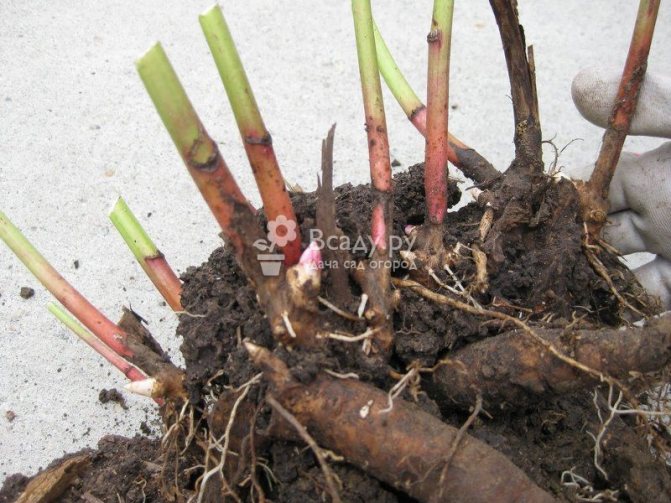

In the fall, the peony is completely cut off
Preparing a peony for wintering
After the autumn pruning, the bushes must be covered with a layer of peat mulch for the winter, especially the young and transplanted plants this year. Adult bushes are not afraid of frost, and easily endure winter.
Taking care of flowers
The flowers are distinguished by a variety of shapes and colors, ranging from red to pale pink with a creamy heart.
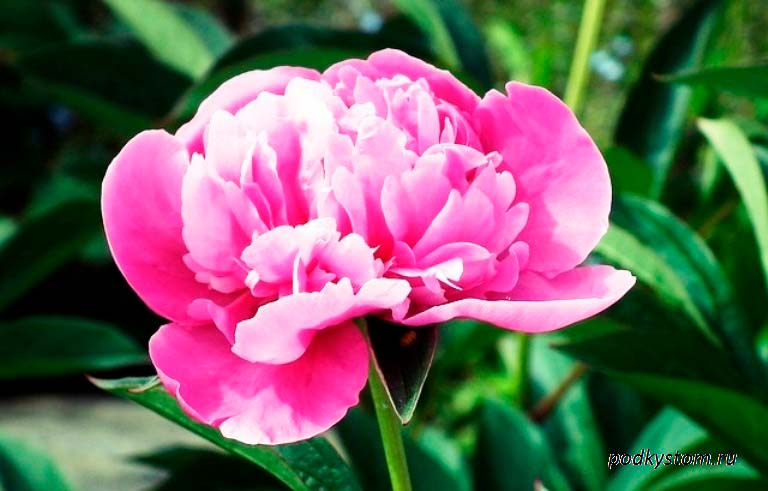

As a rule, the culture begins to bloom from the 3rd year. The length of flowering of the bush reaches two weeks with the spread of an unforgettable aroma. In a dry, sultry summer, it blooms earlier, but fades much faster.
Many varieties have amazingly voluminous caps that often lodge, especially after heavy rainfall. Therefore, the bushes need to organize props.
To obtain flowers of excellent quality from the 3rd year, we stepchild the culture as follows. We keep only one central bud on the stem, but eliminate the lateral ones.
- We also get rid of faded buds, because petals scattered on the ground can lead to the development of gray rot.
- With the arrival of persistent frosts, we cut the stems, leaving stumps above the buds 2-3 cm high.
- For the winter period, we mulch with peat or compost. We do not use straw or foliage to avoid diseases.
To collect a magnificent bouquet, it is better to cut flowers in the morning in dry weather. But completing it, you do not need to get carried away, shredding the bush completely. There should be at least as many stems on the plant as it was cut off. If you cut it more tightly, then there will be no place for new flower buds to emerge, which can significantly worsen flowering for the next season.
We collect plants with dense double flowers in a bouquet only when the lower row of petals opens. If you start this earlier, then the buds will not open or will open with inhibition, and then they will completely crumble so quickly that you will not have time to blink an eye.
The beauty of culture, unfortunately, does not protect it from attacks by pests and diseases.
Plant care
The very first winter passes with the obligatory cover with sawdust or peat with a layer of no more than 15 cm. With the arrival of springtime, we rake everything up. But you can leave a little peat or other organic matter that served as a shelter for use as a bedding.
For the first two years, we will be sure to pinch the emerging buds.
The main actions associated with leaving are loosening, watering, destruction of unnecessary vegetation.
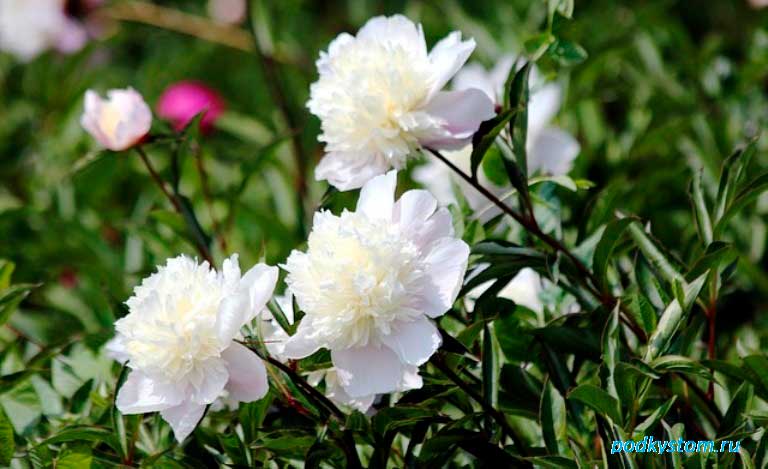

In the presence of dry weather, water until July, which contributes to the formation of full-fledged renewal buds. Further watering is carried out at the end of August - September 2-3 times for a good growth of young adventitious roots. As you can see, watering is rare, but abundant (m2 - 40 l) with a good saturation of soil moisture to the depth of the roots. Watering is carried out in the evening in warm weather.
Variety selection
Before creating a flower garden, which will have to include this culture, it is necessary to decide on the variety. Peonies differ in the shape and color of the flower, as well as in the time of flowering.
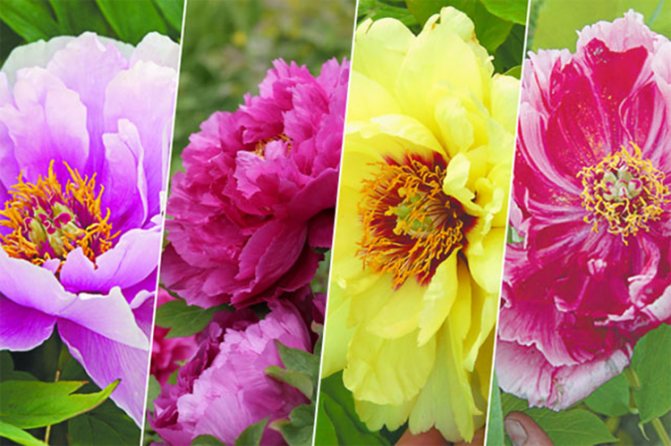

- Early flowering - Mikado, Madame Butterfly, Ballerina, Neon, America. Flowering occurs in late May and lasts until mid-summer. Among these varieties, there are specimens with double and semi-double flowers.
- Mid-flowering peonies are the largest group. These include: Mahogani, Du Tell, Moscow, Cytheria, Red Monarch. These varieties bloom in mid-summer.
- Late varieties bloom at the end of July. Among them the most popular are: Dr. Nilly, Bernice-Carr, Pink Glow.
Flower color: red, pale pink, snow-white. Recently, varieties with coral and yellow flowers have begun to appear, which have become very popular with flower growers.
Also, peonies differ from each other in the shape of the flower and are divided into:
- Semi-double - 2 rows of densely adjacent petals with a bright core, with a pistil in the center and stamens on the sides.
- Terry varieties - densely planted petals form a voluminous cap. With massive flowering, the bush not only looks beautiful, but also saturates the air with an unforgettable aroma.
The latter group, in turn, is divided into two subgroups:
- crown - form a crown from large petals;
- spherical - blossoming petals form a ball shape.
The most popular varieties of peonies
Sarah Bernhardt... The variety is named after the famous actress, as the flower conquers even the coldest hearts with its beauty. The pink-silvery petals bloom and turn into a large fragrant flower. A powerful bush with bright green foliage is immune to many diseases and grows well in central Russia.
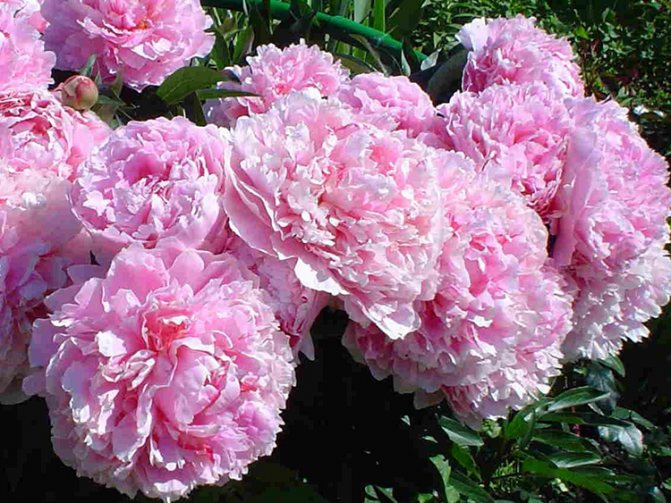

Festival Maxim... A favorite variety for many gardeners, producing large white hats with crimson specks. The bush is high, spreading.
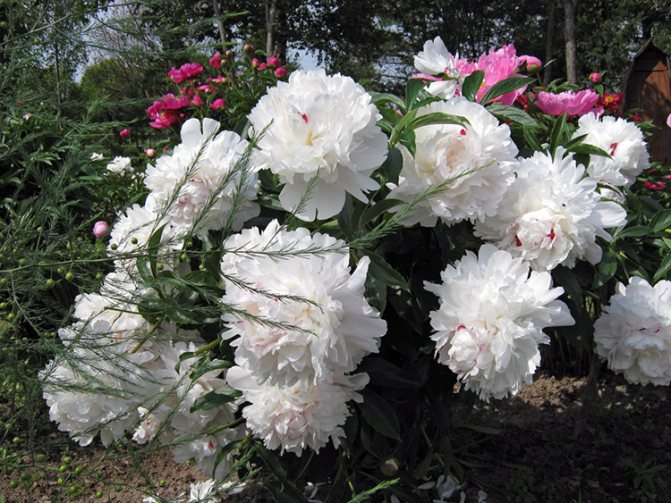

Henry Bockstos... The fiery red flowers grow up to 20 cm in diameter. The shrub is not tall, strongly branched, support is required to support the branches.
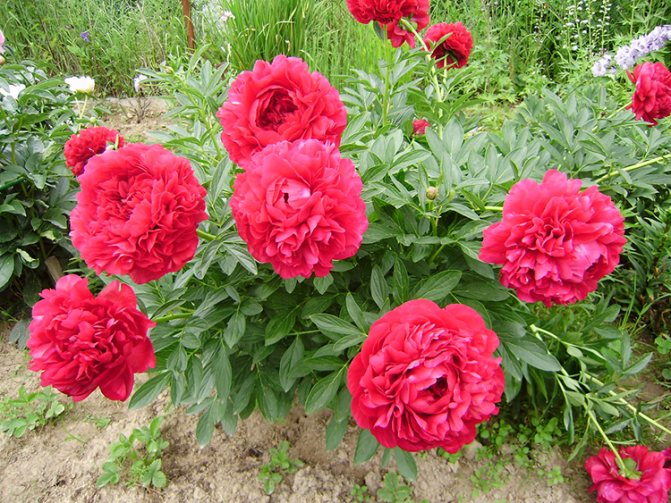

Alexander Fleming. The large bush forms large, bright red flower caps. When blooming massively, the shrub turns into a large fireball.
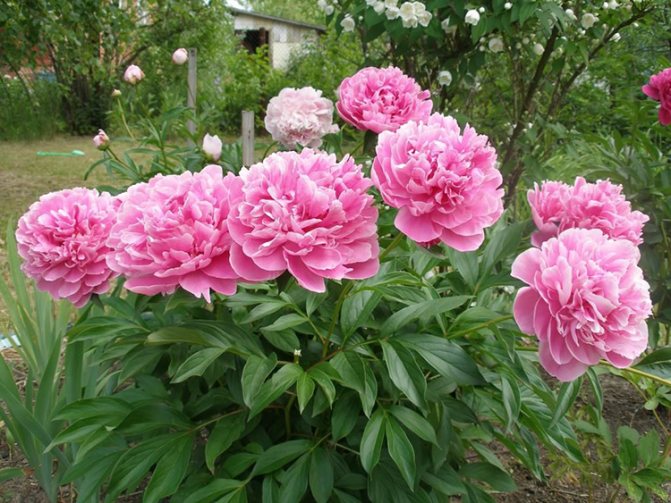

The rarest varieties
Lollipop... A beautiful variety with bright yellow-violet semi-double flowers.
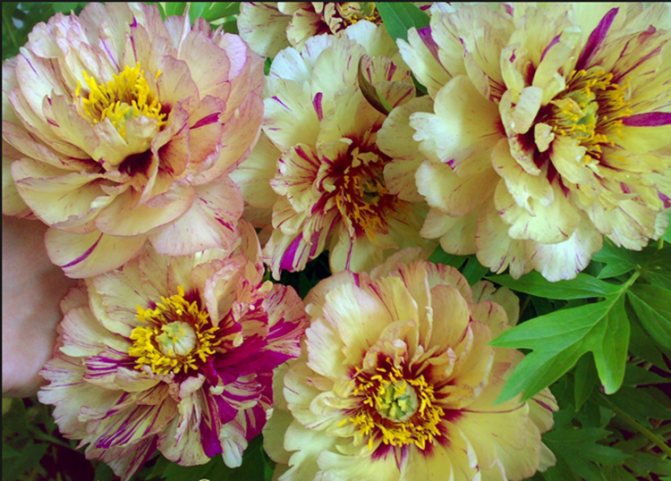

Lemon Dream... A tall shrub, up to 2 meters in height, forms beautiful, fragrant flowers. The plant is resistant to diseases. The disadvantage of the variety is the high price.
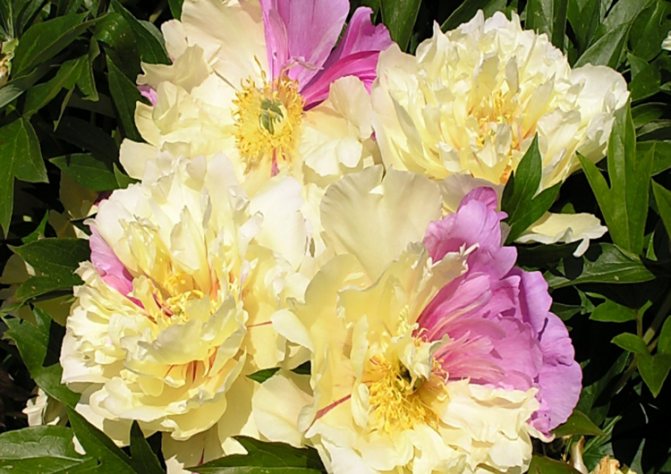

Mister Ed... A variety that changes the color of flowers every year, then white caps bloom, sometimes pink and even multi-colored.
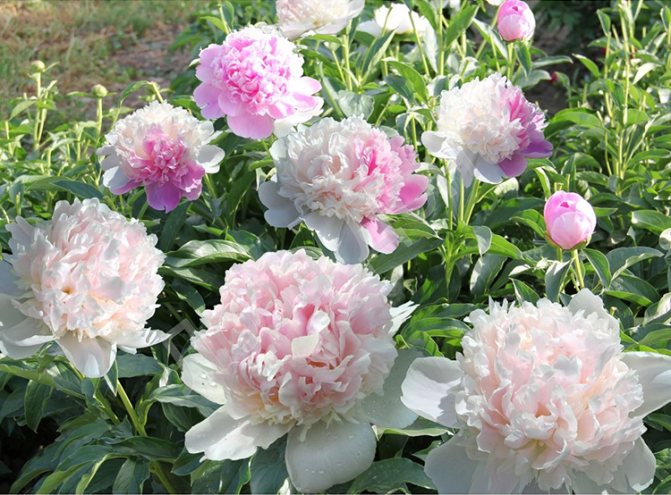

The most fragrant
America... It grows up to 80 cm, the blossoming flowers resemble tulips.
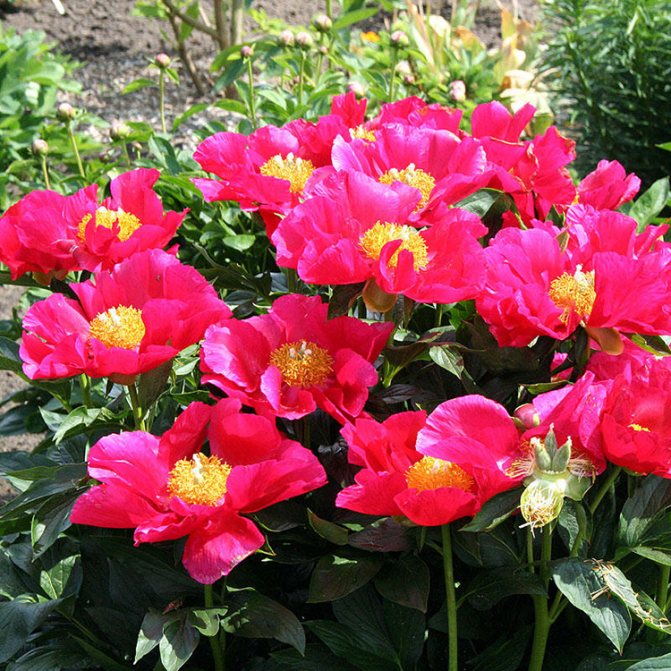

Neon... Vigorous plant with many lateral buds. When mass blooming, they fill the air with a delicate, enchanting aroma.
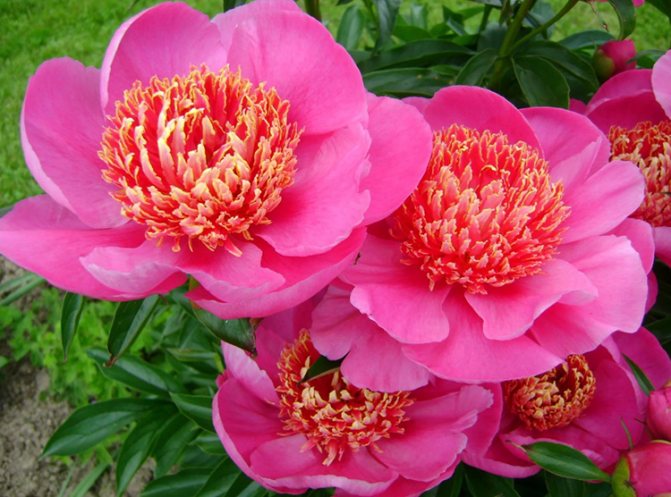

Vogue... A bush with an unusual, strong odor. Plant height does not exceed one meter. Flowers of different shapes can bloom on one bush.
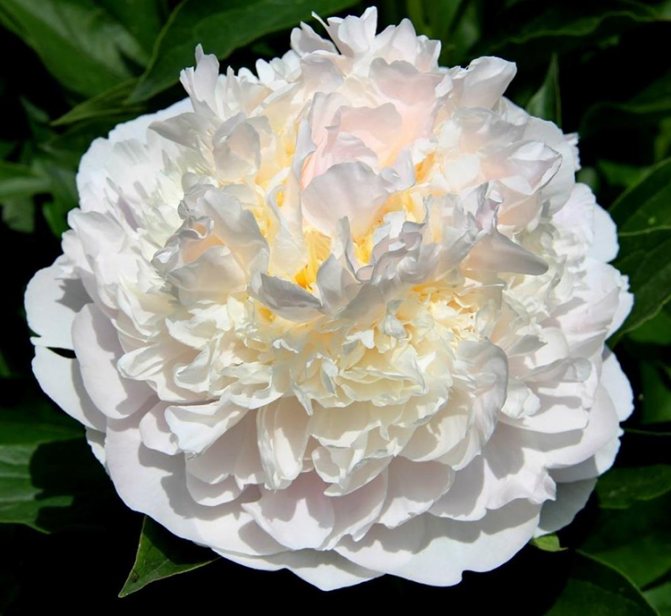

What culture hurts
The main invader, most often appearing on plants growing on damp, acidic clay soils, as well as with an excess of nitrogen, is gray rot (botrytis). But this is just one of a long list of possible ailments. Stem and brown rot, rust, leaf spot, powdery mildew, root decay - as we can see, a rather extensive list.
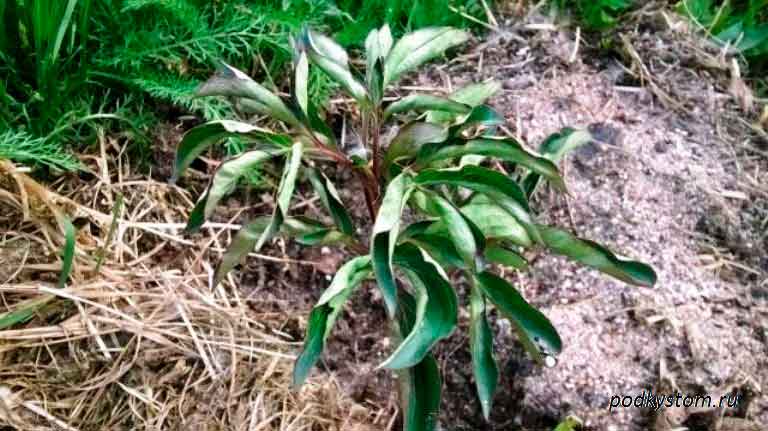

How we fight.
- Once at the very beginning of spring or deep in autumn, we are processing 100 g of copper sulfate, diluted in 10 liters of liquid.
- When planting peonies, we moisten the rhizome cuttings in the composition of 2 Heteroauxin tablets, dissolved in 10 liters.
- 40 g of the preparation "Sulfur colloidal" - 7 liters will go to fight by spraying to get rid of powdery mildew.
- We fight back rust by spraying with 4 ml of Topaz or 100 g of Bordeaux mixture - 10 l of liquid.
It is advisable to carry out spraying activities before and after flowering.
Complementary feeding and fertilization
For good development of the bush, add to the planting soil:
- iron sulfate - one large spoon;
- wood ash - liter;
- potash - a small spoon;
- double superphosphate - glass;
- bone meal - a pound.
For immature plants, foliar dressing is used. Rinse the leaves with a solution of the special fertilizer "Ideal". The required concentration is indicated in the instructions for use of the drug. To make the leaves better wet, you can add a large spoonful of laundry soap to ten liters of water. Watering should be done in the evening, early in the morning, in mid-May.
Flowerbed with peonies scheme
It is worth deciding what peonies are combined with. It is important to determine the compatibility of various flowers, because a flower bed with peonies should be decorative all season.
Flowerbed with peonies scheme
Planning any flower garden requires you to follow several important rules:
- Combination with the general landscape design of the site;
- Use of terrain features (emphasize advantages or hide disadvantages);
- Planting density;
- Duration of flowering of each plant;
- Plant such plants together so that their flowering is continuous throughout the season.
To comply with all these tricks, you need an individual approach to each project. Here it is important to take into account free places for location, illumination, soil composition, the presence of nearby buildings, trees, shrubs, as well as the terrain.
Important! When choosing a place, it must be borne in mind that peonies do not like prolonged shading, stagnant moisture in the soil, acidic and heavy soil, and also do not tolerate peat fertilization.
Several approximate schemes for planting peonies:
- In the center is a group of 3-5 peonies of the same variety, and around the lawn grass or any ground cover plants.
- Peonies go well with hybrid tea varieties of roses. While the roses are forming buds, the peonies are already starting to bloom. When the peonies are blooming, the roses take up the baton, and the dark green narrow leaves of the peonies serve as a great backdrop for them. This is an example of a lawn with peonies and roses.
- Mixborder of dominant peonies (the number of bushes depends on the size of the flower bed) + garden geranium + cuff + decorative onion + aquilegia.
- You can grow a continuous flowering flower bed of peony (1 pc.) + Siberian iris (4 pcs.) + Large rhizome geranium (4 pcs.) + Sedum (4 pcs.) + Yarrow (1 pc.) + Rod-shaped millet (1 pc.) ) + mordovnik ordinary (1 pc.).
Main varieties and types
Each gardener will be able to choose the kind they like at their discretion.
Non-double
For varieties of non-double peonies, the arrangement of large petals in one or two rows is characteristic. The central parts of the flowers are dotted with numerous stamens. The leaf plates of a plant can have a decorative corrugated structure.
Popular varieties of these plants are Golden Glow and Nadia.
Semi-double
The flowers of semi-double peonies are large and light at the same time. The arrangement of the stamens is chaotic - not only in the middle of the flower, but also between its petals, located in most cases in seven rows. The varieties of the variety include An Berry Cousins and Miss America.
Japanese
In Japanese varieties, the petals are arranged in one or more rows. The stamens are located in the upper part and have a modified shape, all together they are formed in the form of a pompon. Famous Japanese varieties are Hot Chocolet with maroon flowers and Carrara with snow-white flowers.
Anemoid
This is a cross between Japanese and terry varieties. In the lower part of the plant there are large, rounded petals that form two rows. Representatives of this variety are the Rhapsody variety with a two-color color (with a pink edge, and a creamy yellowish in the center) and Snow Mantin with soft cream flowers.
Terry
Terry varieties are also represented by a wide variety.
Bomb-shaped
Bomb-shaped peonies have firm stems and lush inflorescences. The color of these flowers is uniform, without overflow.


Hemispherical
The horizontally directed petals form in the form of a hemisphere. In this plant variety, dark foliage contrasts with light delicate flowers.
Spherical
Spherical flowers reach 25 centimeters in diameter. They have a rich uniform color that does not fade under the sun.
Rosy
The flower looks like a rose due to the characteristic structure and arrangement of the petals. Popular varieties are Ballerina, Solange, Goody and Henry Boxstock.
Crowned
There is also a large selection among the crown varieties.
Spherical
They have three tiers. In the middle and at the bottom, the petals are arranged in one row.
Hemispherical
They are distinguished by a three-tiered arrangement of petals with a uniform color. Popular varieties: Aritina Nozen Glory and Nancy.
Where: choose a place
Peony is a perennial herb, therefore, the selection of a place for a flower should be taken very carefully, because in this place the bush will grow for many years. So, the requirements for the landing site:
- Sunny or slightly shaded side, sheltered from the wind. In a very shady place, peonies will bloom poorly;
- There are no trees, large bushes, buildings nearby;
- The place is not very humid, after the rains there should not be water there. If the groundwater comes close (closer than 80-90 cm), the bed with peonies needs to be raised and good drainage done;
- The soil is preferable loamy and slightly acidic. If the soil acidity level is high, throw in a couple of handfuls of lime when preparing the pit for planting.
Why don't peonies bloom?
Below are the reasons why the peony does not bloom and what to do.
- The soil is too poor. Peonies should be planted in permeable but fertile, moderately moist soils. Drying of flower buds occurs on plants planted on sandy soils that are too dry and poor.
- Lack of water during the flowering period. By the time of flowering, especially during a drought, the flowers need quite intensive watering, since the lack of water leads to the drying out of the flower buds. If there was an abundance of water in the soil, this cause can be ruled out.
- Incorrect feeding. The reason for the small flowering or the complete absence of flowers on weaker soils is insufficient mineral or excessive nitrogen fertilization. Since peonies, due to the huge mass of leaves that grow every year, are quite voracious plants in nutrients, from spring they should be fertilized with an inorganic compound fertilizer with microelements, and immediately before flowering, you can additionally apply fertilizers for flowering plants containing increased doses of potassium.
- Gray mold. Due to heavy rainfall and wet weather, peonies can bloom poorly, although they set many buds 0.5 cm in diameter, they turn brown or blackened. The reason is gray mold. Most often, this disease infects plants overfed with nitrogen - such bushes have very large, intensely dark green leaves, soft to the touch. In wet years, plants should be sprayed with a fungicide every 7-10 days (see the label for each drug for details). If the summer is sunny and dry, it is enough to remove the diseased and decaying parts of the plants.
Bloom
The next year, the shoots begin to bloom. But, if even then there are no flowers, this is not the worst thing. The main thing is that the stems, of which there should already be about six or five, are strong and healthy. In the third year, the peony will surely begin to bloom, one at a time, sometimes even three flowers per stem. Large lush flowers bloom, with numerous petals of white or pastel pink, twenty centimeters in size. The bushes of this perennial plant are formed from erect stems up to fifty to sixty centimeters high. The beautifully carved leaves of a deep green color greatly adorn the garden, even when the flowers disappear. In autumn, the stems and leaves take on a crimson hue.
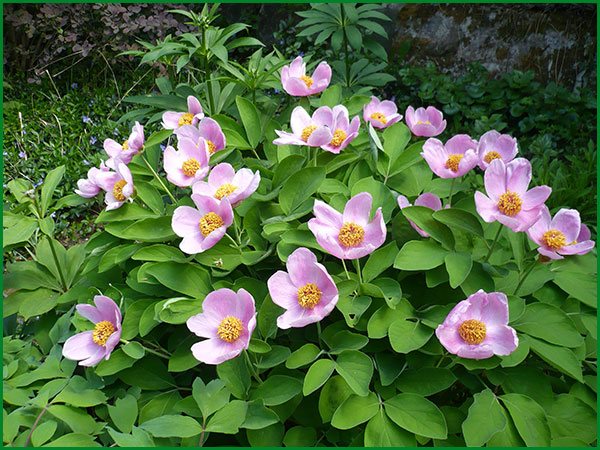

Crimean peony
Flowering lasts about two weeks, each flower stays on the stem for up to eight days.
Flowers are found in different shapes:
- similar to a multi-petaled rose;
- terry;
- spherical;
- semi-double;
- forms of anemones.
Little tricks
If two or three buds have formed on the stem, it is better to pinch off the lateral ones, leaving only one central one. Then the flower will be bigger.
Before flowering, the plants are well watered, making sure that the soil does not dry out while the bushes are blooming and buds are formed for the future. At the same time, it is useful to add fertilizer to the soil, bone meal.
Option one (correct for the middle lane).
The best time to plant a peony in the middle lane is from mid-August to mid-September.At this time, the growth of the ground part of the peony stops, the renewal buds, which will grow in spring, are fully formed, but the process of formation of small roots has not begun. The plant is dormant. During this time, mature plants can be dug up and divided. If the peony had to be planted later, then be sure to cover it for the winter. In this case, the roots will form only in spring, and the peony will bloom a year later. And if spring happens to be hot and dry, then with a late planting you will have to water the plant regularly.
Pests
Peonies attack some pests.
Golden bronze
Symptoms: damaged petals on peony flowers. The pest also feeds on elder flowers, mountain ash and hawthorn.
Reason: Scarabaeidae beetle. These insects are 15-20 mm long. The carapace is golden green with small white dots. In May, bronzes begin to eat plants, peony buds, usually feed until the end of July, sometimes in August. Females lay eggs in the soil after eating.
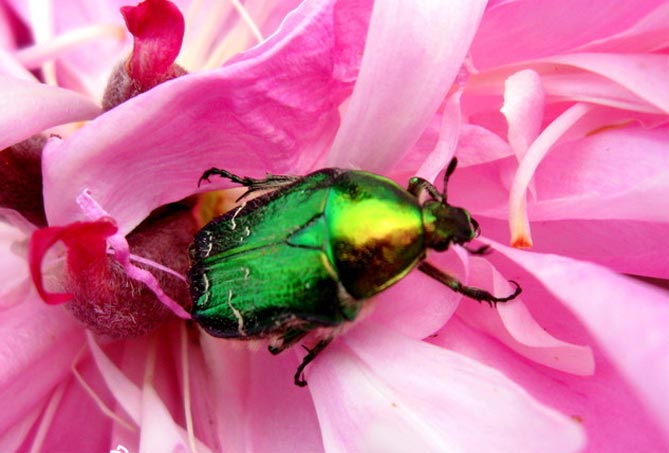

The larvae feed on decaying plant debris, develop in the rotten remains of trees and shrubs, usually in the aboveground and underground parts. At the end of summer, they pupate in cocoons. In the fall, beetles appear, hibernate.
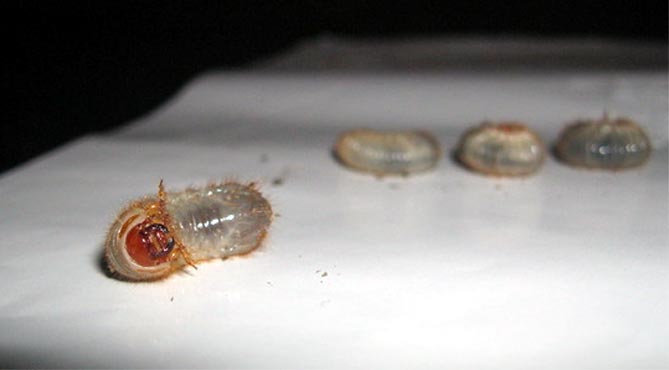

Agrotechnical protection: manual collection of beetles sitting on buds and flowers.
Chemical protection: when there are a lot of beetles, use Decis 2.5 EC spray at a concentration of 0.05%.
Note: Only deal with a very large number of pests when plant damage is high. The larvae live in the substrate, feeding on heavily decayed wood and leaves, which contributes to the creation of compost. Therefore, bronze is useful.
Aphid
If ants are seen on the peony, you should take a closer look, perhaps aphids have appeared. The ants themselves do not threaten the peony buds. They are attracted by the sweet secretion produced by aphids - the ants feed on molasses. Aphids suck the juices of peonies. When it multiplies too much, its activity can dry out the buds, and the peony will not bloom this season. Aphids, foraging for food, secrete abundantly sticky honeydew, on which a fungus grows (a black bloom appears). Fungi, covering the leaf surface, restrict the process of photosynthesis and prevent gas exchange.
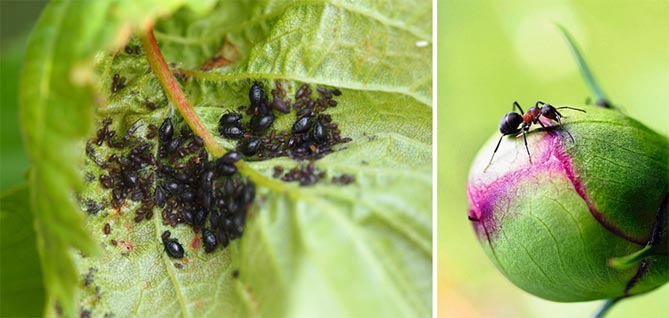

While there are few aphids, you can spray the plant with a solution of soapy water (1 teaspoon per 1 liter of water). If the pests have multiplied too much, chemicals will have to be applied. Insecticides used: Confidor 200 SL, Sumi-Alpha (also destroys thrips). Spraying with the last two agents must be repeated after 7-10 days, because the next generation of aphids will be hatched at this time.

